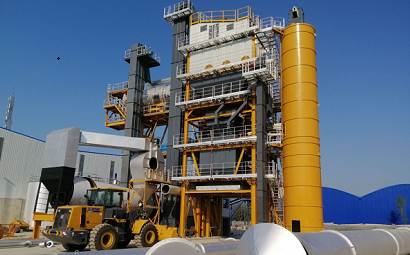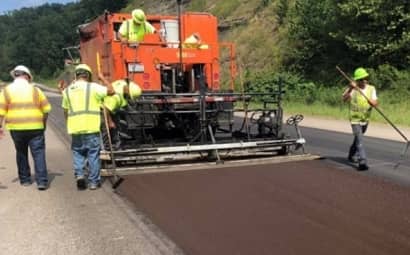Common diseases and maintenance points of asphalt pavement in roads and bridges
[1] Common diseases of asphalt pavement
There are nine types of early damage to asphalt pavement: ruts, cracks, and potholes. These diseases are most common and serious, and are one of the common quality problems of highway projects.
1.1 Rut
Ruts refer to the longitudinal belt-shaped grooves produced along the wheel tracks on the road surface, with a depth of more than 1.5cm. Rutting is a band-shaped groove formed by the accumulation of permanent deformation in the road surface under repeated driving loads. Rutting reduces the smoothness of the road surface. When the ruts reach a certain depth, due to water accumulation in the ruts, cars are most likely to slide and cause traffic accidents. Rutting is mainly caused by unreasonable design and serious overloading of vehicles.
1.2 Cracks
There are three main forms of cracks: longitudinal cracks, transverse cracks and network cracks. Cracks occur in asphalt pavement, causing water seepage and harming the surface layer and base layer.
1.3 Pit and groove
Potholes are a common early disease of asphalt pavement, which refers to the damage of the pavement into potholes with a depth of more than 2cm and an area of ??more than 0.04㎡. Potholes are formed mainly when vehicle repairs or motor vehicle oil seep into the road surface. The pollution causes the asphalt mixture to loosen, and the potholes are gradually formed by driving and rolling.
1.4 Peeling
Asphalt pavement peeling refers to the layered peeling off of the pavement surface, with an area of ??more than 0.1 square meters. The main cause of peeling asphalt pavement is water damage.
1.5 loose
Looseness of asphalt pavement refers to the loss of bonding force of the pavement binder and loosening of aggregates, with an area of ??more than 0.1 square meters.


[2] Maintenance measures for common diseases of asphalt pavement
For diseases that occur in the early stage of asphalt pavement, we must perform repair work in time, so as to minimize the impact of the disease on the driving safety of asphalt pavement.
2.1 Repair of ruts
The main methods for repairing asphalt road ruts are as follows:
2.1.1 If the lane surface is rutted due to the movement of vehicles. Rutted surfaces should be removed by cutting or milling, and then the asphalt surface should be resurfaced. Then use asphalt mastic gravel mixture (SMA) or SBS modified asphalt single mixture, or polyethylene modified asphalt mixture to repair the ruts.
2.1.2 If the road surface is pushed laterally and forms lateral corrugated ruts, if it has stabilized, the protruding parts can be cut off, and the trough parts can be sprayed or painted with bonded asphalt and filled with asphalt mixture, leveled, and compacted.
2.1.3 If rutting is caused by partial subsidence of the base layer due to insufficient strength and poor water stability of the base layer, the base layer should be treated first. Completely remove the surface layer and base layer
2.2 Repair of cracks
After the asphalt pavement cracks occur, if all or most of the minor cracks can be healed during the high temperature season, no treatment is required. If there are minor cracks that cannot be healed during the high temperature season, they must be repaired in time to control the further expansion of the cracks, prevent early damage to the pavement, and improve the efficiency of highway use. Similarly, when repairing cracks in asphalt pavement, strict process operations and specification requirements must be followed.
2.2.1 Oil filling repair method. In winter, clean the vertical and horizontal cracks, use liquefied gas to heat the crack walls to a viscous state, then spray asphalt or asphalt mortar (emulsified asphalt should be sprayed in low-temperature and humid seasons) into the cracks, and then spread evenly Protect it with a layer of dry clean stone chips or coarse sand of 2 to 5 mm, and finally use a light roller to crush the mineral materials. If it is a small crack, it should be widened in advance with a disc milling cutter, and then processed according to the above method, and a small amount of asphalt with a low consistency should be applied along the crack.
2.2.2 Repair cracked asphalt pavement. During construction, first chisel out the old cracks to form a V-shaped groove; then use an air compressor to blow out the loose parts and dust and other debris in and around the V-shaped groove, and then use an extrusion gun to mix the evenly mixed The repair material is poured into the crack to fill it. After the repair material solidifies, it will be open to traffic in about a day. In addition, if there are serious cracks due to insufficient strength of the soil foundation or base layer or roadbed slurry, the base layer should be treated first and then the surface layer should be reworked.
2.3 Care of pits
2.3.1 The care method when the base layer of the road surface is intact and only the surface layer has potholes. According to the principle of "round hole square repair", draw the outline of the pothole repair parallel or perpendicular to the center line of the road. Carry out according to the rectangle or square. Cut the pothole to the stable part. Use an air compressor to clean the bottom of the groove and the groove. Clean the dust and loose parts of the wall, and then spray a thin layer of bonded asphalt on the clean bottom of the tank; the tank wall is then filled with the prepared asphalt mixture. Then roll it with a hand roller, making sure that the compaction force acts directly on the paved asphalt mixture. With this method, cracks, cracks, etc. will not occur.
2.3.1 Repair by hot patching method. A hot repair maintenance vehicle is used to heat the road surface in the pit with a heating plate, loosen the heated and softened pavement layer, spray emulsified asphalt, add new asphalt mixture, then stir and pave, and compact it with a road roller.
2.3.3 If the base layer is damaged due to insufficient local strength and pits are formed, the surface layer and base layer should be completely excavated.
2.4 Repair of peeling
2.4.1 Due to poor bonding between the asphalt surface layer and the upper sealing layer, or peeling caused by poor initial maintenance, the peeled and loose parts should be removed, and then the upper sealing layer should be remade. The amount of asphalt used in the sealing layer should be And the particle size specifications of mineral materials should depend on the thickness of the sealing layer.
2.4.2 If peeling occurs between the asphalt surface layers, the peeling and loose parts should be removed, the lower asphalt surface should be painted with bonded asphalt, and the asphalt layer should be redone.
2.4.3 If peeling occurs due to poor bonding between the surface layer and the base layer, the peeling and loose surface layer should be removed first and the cause of the poor bonding should be analyzed.
2.5 Loose maintenance
2.5.1 If there is slight pitting due to the loss of caulking material, when the asphalt surface layer is not depleted of oil, appropriate caulking material can be sprinkled in high temperature seasons and swept evenly with a broom to fill the gaps in the stone with the caulking material.
2.5.2 For large areas of pockmarked areas, spray asphalt with a higher consistency and sprinkle caulking materials with appropriate particle sizes. The caulking material in the middle of the pockmarked area should be slightly thicker, and the surrounding interface with the original road surface should be slightly thinner and neatly shaped. And rolled into shape.
2.5.3 The road surface is loose due to poor adhesion between asphalt and acidic stone. All loose parts should be dug out and then the surface layer should be remade. Acidic stones should not be used when resurfacing mineral materials.
 Albanian
Albanian  Russian
Russian  Arabic
Arabic  Amharic
Amharic  Azerbaijani
Azerbaijani  Irish
Irish  Estonian
Estonian  Odia (Oriya)
Odia (Oriya)  Basque
Basque  Belarusian
Belarusian  Bulgarian
Bulgarian  Icelandic
Icelandic  Polish
Polish  Bosnian
Bosnian  Persian
Persian  Afrikaans
Afrikaans  Tatar
Tatar  Danish
Danish  German
German  French
French  Filipino
Filipino  Finnish
Finnish  Frisian
Frisian  Khmer
Khmer  Georgian
Georgian  Gujarati
Gujarati  Kazakh
Kazakh  Haitian Creole
Haitian Creole  Korean
Korean  Hausa
Hausa  Dutch
Dutch  Kyrgyz
Kyrgyz  Galician
Galician  Catalan
Catalan  Czech
Czech  Kannada
Kannada  Corsican
Corsican  Croatian
Croatian  Kurdish (Kurmanji)
Kurdish (Kurmanji)  Latin
Latin  Latvian
Latvian  Lao
Lao  Lithuanian
Lithuanian  Luxembourgish
Luxembourgish  Kinyarwanda
Kinyarwanda  Romanian
Romanian  Malagasy
Malagasy  Maltese
Maltese  Marathi
Marathi  Malayalam
Malayalam  Malay
Malay  Macedonian
Macedonian  Maori
Maori  Mongolian
Mongolian  Bengali
Bengali  Myanmar (Burmese)
Myanmar (Burmese)  Hmong
Hmong  Xhosa
Xhosa  Zulu
Zulu  Nepali
Nepali  Norwegian
Norwegian  Punjabi
Punjabi  Portuguese
Portuguese  Pashto
Pashto  Chichewa
Chichewa  Japanese
Japanese  Swedish
Swedish  Samoan
Samoan  Serbian
Serbian  Sesotho
Sesotho  Sinhala
Sinhala  Esperanto
Esperanto  Slovak
Slovak  Slovenian
Slovenian  Swahili
Swahili  Scots Gaelic
Scots Gaelic  Cebuano
Cebuano  Somali
Somali  Tajik
Tajik  Telugu
Telugu  Tamil
Tamil  Thai
Thai  Turkish
Turkish  Turkmen
Turkmen  Welsh
Welsh  Uyghur
Uyghur  Urdu
Urdu  Ukrainian
Ukrainian  Uzbek
Uzbek  Spanish
Spanish  Hebrew
Hebrew  Greek
Greek  Hawaiian
Hawaiian  Sindhi
Sindhi  Hungarian
Hungarian  Shona
Shona  Armenian
Armenian  Igbo
Igbo  Italian
Italian  Yiddish
Yiddish  Hindi
Hindi  Sundanese
Sundanese  Indonesian
Indonesian  Javanese
Javanese  Yoruba
Yoruba  Vietnamese
Vietnamese  Hebrew
Hebrew  Chinese (Simplified)
Chinese (Simplified)







